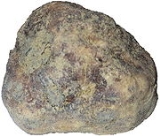
Pezizales
Encyclopedia
The Pezizales are an order
of the subphylum Pezizomycotina
within the phylum Ascomycota
. The order contains 16 families
, 199 genera
, and 1683 species
. It contains a number of species of economic importance, such as morels, the black and white truffles, and the desert truffles. The Pezizales are saprobic, mycorrhizal, or parasitic on plants. Species grow on soil, wood, leaves and dung. Soil-inhabiting species often fruit in habitats with a high pH and low content of organic matter, including disturbed ground. Most species occur in temperate
regions or at high elevation. Several members of the Sarcoscyphaceae
and Sarcosomataceae
are common in tropical regions.
that typically open by rupturing to form a terminal or eccentric lid or operculum. The ascomata are apothecia or are closed structures of various forms derived from apothecia. Apothecia range in size from less than a millimeter to approximately 15 cm, and may be stalked or sessile. The order includes epigeous, semihypogeous to hypogeous (truffles) taxa. The ascospore
s are single-celled, bipolar symmetrical, and usually bilaterally symmetrical, ranging from roughly spherical to ellipsoidal to occasionally fusoid. The ascospores of some species develop surface ornamentations such as warts, ridges, or spines. The tissues of the ascomata are fleshy and often fragile. Although the majority of species are known only in the teleomorphic state, the anamorphs of some species are known.
Order (biology)
In scientific classification used in biology, the order is# a taxonomic rank used in the classification of organisms. Other well-known ranks are life, domain, kingdom, phylum, class, family, genus, and species, with order fitting in between class and family...
of the subphylum Pezizomycotina
Pezizomycotina
Pezizomycotina contains the filamentous ascomycetes and is a subphylum of the Ascomycota . It is more or less synonymous with the older taxon Euascomycota...
within the phylum Ascomycota
Ascomycota
The Ascomycota are a Division/Phylum of the kingdom Fungi, and subkingdom Dikarya. Its members are commonly known as the Sac fungi. They are the largest phylum of Fungi, with over 64,000 species...
. The order contains 16 families
Family (biology)
In biological classification, family is* a taxonomic rank. Other well-known ranks are life, domain, kingdom, phylum, class, order, genus, and species, with family fitting between order and genus. As for the other well-known ranks, there is the option of an immediately lower rank, indicated by the...
, 199 genera
Genera
Genera is a commercial operating system and development environment for Lisp machines developed by Symbolics. It is essentially a fork of an earlier operating system originating on the MIT AI Lab's Lisp machines which Symbolics had used in common with LMI and Texas Instruments...
, and 1683 species
Species
In biology, a species is one of the basic units of biological classification and a taxonomic rank. A species is often defined as a group of organisms capable of interbreeding and producing fertile offspring. While in many cases this definition is adequate, more precise or differing measures are...
. It contains a number of species of economic importance, such as morels, the black and white truffles, and the desert truffles. The Pezizales are saprobic, mycorrhizal, or parasitic on plants. Species grow on soil, wood, leaves and dung. Soil-inhabiting species often fruit in habitats with a high pH and low content of organic matter, including disturbed ground. Most species occur in temperate
Temperate
In geography, temperate or tepid latitudes of the globe lie between the tropics and the polar circles. The changes in these regions between summer and winter are generally relatively moderate, rather than extreme hot or cold...
regions or at high elevation. Several members of the Sarcoscyphaceae
Sarcoscyphaceae
The Sarcoscyphaceae are a family of cup fungi in the Pezizales order. There are 13 genera and 102 species in the family. Members of this family are cosmopolitan in distribution, being found in both tropical and temperate regions.-External links:...
and Sarcosomataceae
Sarcosomataceae
The Sarcosomataceae are a family of fungi in the order Pezizales. According to a 2008 estimate, the family contains 10 genera and 57 species. Most species are found in temperate areas, and are typically saprobic on rotten or buried wood....
are common in tropical regions.
Description
Members of this order are characterized by asciAscus
An ascus is the sexual spore-bearing cell produced in ascomycete fungi. On average, asci normally contain eight ascospores, produced by a meiotic cell division followed, in most species, by a mitotic cell division. However, asci in some genera or species can number one , two, four, or multiples...
that typically open by rupturing to form a terminal or eccentric lid or operculum. The ascomata are apothecia or are closed structures of various forms derived from apothecia. Apothecia range in size from less than a millimeter to approximately 15 cm, and may be stalked or sessile. The order includes epigeous, semihypogeous to hypogeous (truffles) taxa. The ascospore
Ascospore
An ascospore is a spore contained in an ascus or that was produced inside an ascus. This kind of spore is specific to fungi classified as ascomycetes ....
s are single-celled, bipolar symmetrical, and usually bilaterally symmetrical, ranging from roughly spherical to ellipsoidal to occasionally fusoid. The ascospores of some species develop surface ornamentations such as warts, ridges, or spines. The tissues of the ascomata are fleshy and often fragile. Although the majority of species are known only in the teleomorphic state, the anamorphs of some species are known.

